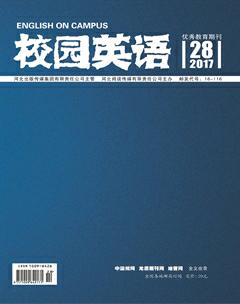An Brief Introduction to Bildungsroman
杜文秀
As a special literary genre, Bildunsroman has a high position in the literary history. For centuries, scholars have given Bildunsroman a comprehensive definition. However, due to the different types and stories the novelists narrated, its hard to define it concisely.
Bildunsroman and Erziehunsroman are German terms signifying “novel of formation”. Its subject is the development of the protagonists mind and character from childhood into maturity, through various experiences, including a spiritual crisis, which may involves recognition of ones identity. (Abrams, 2005: 193)
Originated in 18th century Germany, Bildunsroman, first appeared in Friedrich von Blanckensburgs “essay on the Novel”. Morgenstern gave the first definition of it in his university lectures. He proposed two main features of it: “first, a Bildunsroman illustrates the protagonists growth (i.e., ‘Bildung). Second, by depicting the protagonists development, a Bildunsroman contributes also to the readers growth more than any other novel type” (qtd. In Twark 129).
The key point of Bildungsroman lies in expressing the experiences of the character obtained from socialization. Thus the hero or heroine may endure the confusion of stepping into the adult world from ignorance. “Buildung” is German and “roman” means “novel” in French (Hamilton, 1974: 35). Since 18th century, “Bildung” referred to the interaction between man and nature, and among men themselves. But it emphasized more on the shaping of inner world and purification of mind. In this period, the Enlightenment evolved “Bildung” into “education and training”, which focused on the search for rationality and extrovert “shaping”. Thus “Bildung” had a heavier sense of morality (谷裕, 2001: 125). In Experience and Poetry, Germany philosopher Wilhelm Dilthey argued that “the typical Bildunsroman traces the progress of a young person toward self-understanding as well as a sense of social responsibility.” (qtd. In Summerfield and Downward 1). Wilhelm Dilthey defines Bildungsroman as a literary form where “A regulated development within the life of the individual is observed;each of its stage has its own intrinsic value and is at the same time the basis for a higher stage. The dissonance and conflicts of life appear as the necessary growth points through which the individual must pass on his way to maturity and harmony.”[10]xiv Briefly speaking, the traditional Bildungsroman emphasizes the internal changes of a hero going through difficulties during his upward development. From him, the discussion of the individual development begins to gain its reasonable space. Although there are still limitations of Diltheys definition, “Bildungsroman” had become an acknowledged and frequently cited term.endprint
Goethes Wilhelm Meisters Apprenticeship (1795-6), was recognized as the first Bildungsroman, which created the tradition of protagonists reconciliation and integration with society. Some comments defined that Bildungsroman is kind of growth story according to the style of Wilhelm Meister (Sue, 1990: 21). Bildunsroman started in Europe in the late 18th century, and later spread to England. Thomas Carlyle imitates Wilhelm Meisters Lehrjahre in his own work Sartor Resartus. After the publication of an autobiographical work of Thomas Carlyle and the adaptation of Sartor Resartus, Bildungsroman was soon embraced by the English writers. Charlotte Brontes Jane Eyre (1847) and Charles Dickenss Great Expectations (1861) are representatives of the Bildungsroman genre. England inherited the elements of Bildungsroman from Germany but novelized them with British features. For example, except those with orphan features, most of the heroes in Englands Bildungsroman were “young people from other provinces” (Trilling, 1957: 58), especially from remote villages. The environment nurtured their pure character, and foretold their purpose to London—to pursue a dream with aspiration. These people were clever, and in lack of worldly wisdom. They faced the secular society with sensitive spiritual temperament, considering the society somewhat harmful. (Burckley, 1974;13). And the story always end hopelessly. Thomas Jeffers pointed out the new features in British: “ones development as I depended not only on the richness of ones inner life, but on the affiliations one had with the people.”(35)
Bildunsroman was adopted by American writers in the 18th century. Mark Twains The Adventures of Huckleberry Finn and Stephen Cranes The Red Badge of Courage are good examples. The typical themes of American initiation story include disillusionment of American dream, the plight of the lost generation and black humor. The 20th centurys famous Bildungsromans are Jay J.D. Salingers The Catcher in the Rye (1951) and Michael Chabons Mysteries of Pittsburgh (1987). American scholar Mordecai Marcus used “initiation story” as the synonym for Bildunsroman. In his article, he defined it as follows:
An initiation story may be said to show its young protagonist experiencing a significant change of knowledge about the world or himself, or a change of character, or of both, and this change must point or lead him towards an adult world. (32)
Despite the fact that each definition has a different emphasis, its accepted that a bildunsroman focuses on the development of one character, and traces the protagonists emotional and intellectual growth from innocence to maturity.endprint

